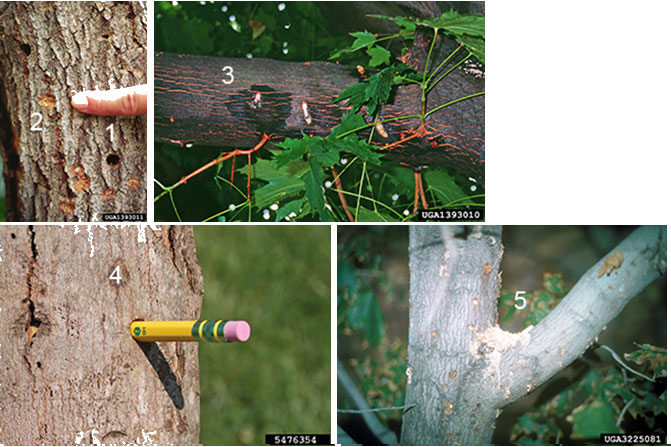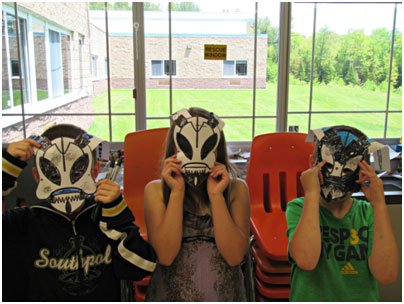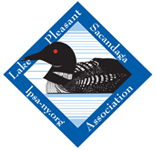Asian Lonhorned Beetle
| What is a Asian Longhorned Beetle? | ||
 The Asian longhorned beetle, or ALB, is an invasive wood-boring insect that feeds on a variety of hardwoods including maple, birch, elm, ash, poplar, horsechestnut, and willow, among others. Native to China and Korea, the beetles are approximately 1.5 inches long and shiny black, with white spots on their wing cases. They have black and white antennae that can be up to twice as long as their body. View the ALB fact sheet. (PDF, 500 KB) The Asian longhorned beetle, or ALB, is an invasive wood-boring insect that feeds on a variety of hardwoods including maple, birch, elm, ash, poplar, horsechestnut, and willow, among others. Native to China and Korea, the beetles are approximately 1.5 inches long and shiny black, with white spots on their wing cases. They have black and white antennae that can be up to twice as long as their body. View the ALB fact sheet. (PDF, 500 KB)Where are ALB located? View a map showing locations of ALB infestations. In 1996, ALB were found infesting Norway maple trees in Brooklyn. Larvae and pupae likely hitchhiked from China in wooden packing material and the adult beetles emerged after the materials reached the New York Harbor. Additional infestations were later discovered in Manhattan, Queens, Staten Island, Islip and central Long Island. To date, the Manhattan, eastern Queens, Staten Island, and Islip infestation sites have been eradicated. What are the signs of an infestation? Trees being attacked by ALB often have wilted foliage and canopy dieback, but the main signs to look for include:
 (photo credit, from left to right: photos 1 & 2 by Dennis Haugen, USDA Forest Service; Joe Boggs, Ohio State University; Robert A. Haack, USDA Forest Service) What do they do to trees? Females often chew depressions in the bark where they deposit one to two eggs at a time, laying up to sixty eggs on average. After they hatch, the larvae bore into the tree and begin feeding on the living tissue just underneath the bark which disrupts the nutrient and water flow within the tree. The larvae then continue deep into the heartwood where they continue to feed until they are ready to pupate. Repeated attacks from scores of larvae, generation after generation, eventually girdles the tree and kills it. Tree death usually occurs 7-9 years after the initial infestation, depending on site conditions and the tree's overall health. What is the risk to NYS? Since maples are a preferred host for ALB, the spread of the beetle into the rest of the state would mean devastating impacts to the maple syrup industry through the loss of healthy sugar bush. Maples are also a valuable hardwood for furniture, flooring, and other uses. Larval galleries through the heartwood may degrade the wood enough to make it useless for milling, costing the forest products industry billions of dollars. The larval galleries also compromise the structural integrity of the tree resulting in falling limbs and trunks under heavy rain, snow or wind pressure. Removing these hazard trees in parks and towns would be expensive and have serious impacts on property values and tourism. What is being done?
What can I do?
More about Asian Longhorned Beetle (ALB):
https://www.dec.ny.gov/animals/7255.html – New York State DEC ~ Asian Longhorned Beetle = = = = = = = = = = = = = = = = = = = = = = = = = = = = = = = = = = = = = = = = = = = = = = Award Winning Photo  Hamilton County Soil and Water Conservation District's Conservation Educator Caitlin Stewart received first place for the National Association of Conservation Districts' annual photo contest. She placed first in the Conservation in Action category for her photo titled “Asian longhorn beetle masquerade”. The photo shows students at Lake Pleasant Central School wearing masks they created while learning about invasive insects. Caitlin Stewart said she was honored to receive the award, and added “The photo brings a smile to my face because it captured kids learning about invasive insects while showing off masks they created. These young people are the future stewards of our environment, and that future is so bright!” |
||
 |
||
|
| What is a Asian Longhorned Beetle? | ||
 The Asian longhorned beetle, or ALB, is an invasive wood-boring insect that feeds on a variety of hardwoods including maple, birch, elm, ash, poplar, horsechestnut, and willow, among others. Native to China and Korea, the beetles are approximately 1.5 inches long and shiny black, with white spots on their wing cases. They have black and white antennae that can be up to twice as long as their body. View the ALB fact sheet. (PDF, 500 KB) The Asian longhorned beetle, or ALB, is an invasive wood-boring insect that feeds on a variety of hardwoods including maple, birch, elm, ash, poplar, horsechestnut, and willow, among others. Native to China and Korea, the beetles are approximately 1.5 inches long and shiny black, with white spots on their wing cases. They have black and white antennae that can be up to twice as long as their body. View the ALB fact sheet. (PDF, 500 KB)Where are ALB located? View a map showing locations of ALB infestations. In 1996, ALB were found infesting Norway maple trees in Brooklyn. Larvae and pupae likely hitchhiked from China in wooden packing material and the adult beetles emerged after the materials reached the New York Harbor. Additional infestations were later discovered in Manhattan, Queens, Staten Island, Islip and central Long Island. To date, the Manhattan, eastern Queens, Staten Island, and Islip infestation sites have been eradicated. What are the signs of an infestation? Trees being attacked by ALB often have wilted foliage and canopy dieback, but the main signs to look for include:
 (photo credit, from left to right: photos 1 & 2 by Dennis Haugen, USDA Forest Service; Joe Boggs, Ohio State University; Robert A. Haack, USDA Forest Service) What do they do to trees? Females often chew depressions in the bark where they deposit one to two eggs at a time, laying up to sixty eggs on average. After they hatch, the larvae bore into the tree and begin feeding on the living tissue just underneath the bark which disrupts the nutrient and water flow within the tree. The larvae then continue deep into the heartwood where they continue to feed until they are ready to pupate. Repeated attacks from scores of larvae, generation after generation, eventually girdles the tree and kills it. Tree death usually occurs 7-9 years after the initial infestation, depending on site conditions and the tree's overall health. What is the risk to NYS? Since maples are a preferred host for ALB, the spread of the beetle into the rest of the state would mean devastating impacts to the maple syrup industry through the loss of healthy sugar bush. Maples are also a valuable hardwood for furniture, flooring, and other uses. Larval galleries through the heartwood may degrade the wood enough to make it useless for milling, costing the forest products industry billions of dollars. The larval galleries also compromise the structural integrity of the tree resulting in falling limbs and trunks under heavy rain, snow or wind pressure. Removing these hazard trees in parks and towns would be expensive and have serious impacts on property values and tourism. What is being done?
What can I do?
More about Asian Longhorned Beetle (ALB):
https://www.dec.ny.gov/animals/7255.html – New York State DEC ~ Asian Longhorned Beetle = = = = = = = = = = = = = = = = = = = = = = = = = = = = = = = = = = = = = = = = = = = = = = Award Winning Photo  Hamilton County Soil and Water Conservation District's Conservation Educator Caitlin Stewart received first place for the National Association of Conservation Districts' annual photo contest. She placed first in the Conservation in Action category for her photo titled “Asian longhorn beetle masquerade”. The photo shows students at Lake Pleasant Central School wearing masks they created while learning about invasive insects. Caitlin Stewart said she was honored to receive the award, and added “The photo brings a smile to my face because it captured kids learning about invasive insects while showing off masks they created. These young people are the future stewards of our environment, and that future is so bright!” |
||
 |
||
|




